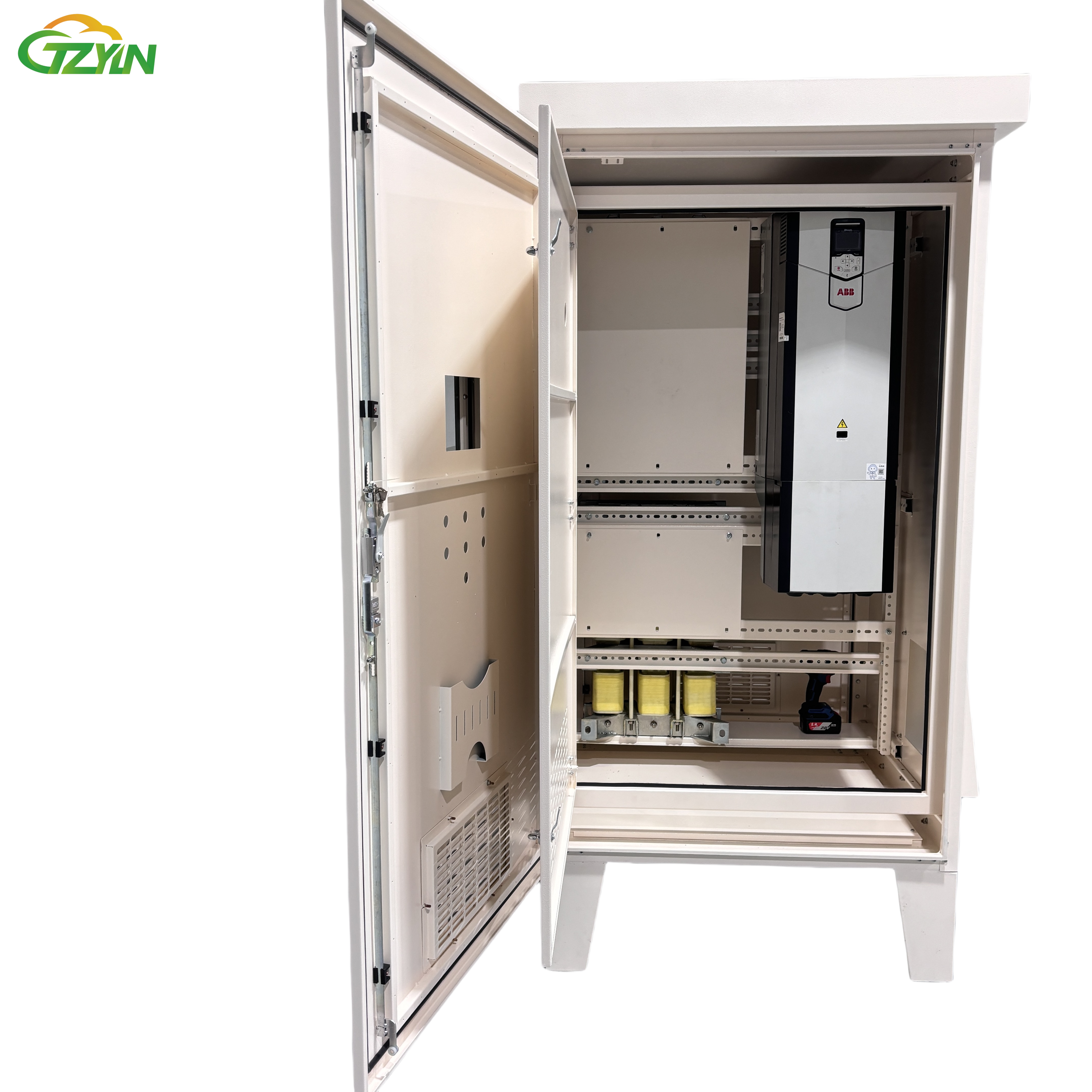Tủ chuyển đổi tần số đóng một vai trò quan trọng trong quản lý năng lượng hiện đại. Các hệ thống này điều chỉnh tốc độ động cơ để phù hợp với nhu cầu hoạt động, đảm bảo sử dụng năng lượng hiệu quả. Bằng cách tối ưu hóa tiêu thụ năng lượng, chúng giúp bạn giảm chi phí điện trong khi vẫn duy trì hiệu suất. Việc áp dụng chúng đã trở nên thiết yếu trong các ngành công nghiệp và không gian thương mại, nơi hiệu quả năng lượng là ưu tiên. Bạn có thể dựa vào các tủ này để giảm thiểu chất thải và cải thiện tính bền vững trong hoạt động của bạn. Khả năng tăng hiệu quả hệ thống làm cho chúng trở thành nền tảng của các công nghệ tiết kiệm năng lượng.
Làm thế nào để làm việc của tủ chuyển đổi tần số
Kiểm soát tốc độ động cơ
Tủ chuyển đổi tần số cho phép bạn điều khiển tốc độ động cơ một cách chính xác. Các tủ này điều chỉnh tần số của điện năng được cung cấp cho động cơ. Bằng cách đó, chúng đảm bảo rằng động cơ hoạt động với tốc độ chính xác cần thiết cho nhiệm vụ. Điều này loại bỏ việc sử dụng năng lượng không cần thiết do động cơ chạy ở tốc độ tối đa khi không cần thiết. Ví dụ, trong các hệ thống như quạt hoặc máy bơm, bạn có thể giảm tốc độ động cơ trong thời gian nhu cầu thấp, làm giảm đáng kể mức tiêu thụ năng lượng.
Điều khiển này cũng cải thiện hiệu suất của thiết bị của bạn. Các động cơ chạy ở tốc độ tối ưu sẽ ít bị mòn hơn. Điều này làm cho chúng có tuổi thọ lâu hơn và giảm nhu cầu sửa chữa thường xuyên. Bạn kiểm soát hoạt động tốt hơn trong khi tiết kiệm chi phí bảo trì. Khả năng điều chỉnh tốc độ động cơ làm cho tủ chuyển đổi tần số trở thành một công cụ có giá trị để cải thiện hiệu quả trong các hệ thống động cơ.
Tối ưu hóa việc sử dụng năng lượng
Tủ chuyển đổi tần số tối ưu hóa việc sử dụng năng lượng bằng cách phù hợp với năng lượng sản xuất theo nhu cầu thực tế. Các hệ thống truyền thống thường lãng phí năng lượng vì chúng hoạt động ở tốc độ cố định bất kể khối lượng công việc. Với các tủ chuyển đổi tần số, bạn có thể tránh được sự không hiệu quả này. Các tủ này điều chỉnh cả tần số và điện áp được cung cấp cho động cơ, đảm bảo rằng động cơ chỉ sử dụng năng lượng cần thiết.
Việc tối ưu hóa này đặc biệt có lợi trong các ứng dụng như hệ thống HVAC, sản xuất và trạm bơm nước. Ví dụ, trong trạm bơm nước, tủ có thể làm giảm tốc độ bơm khi nhu cầu nước thấp. Điều chỉnh này dẫn đến tiết kiệm năng lượng đáng kể mà không ảnh hưởng đến hiệu suất. Bằng cách sử dụng tủ chuyển đổi tần số, bạn có thể đạt được sự cân bằng giữa hiệu quả năng lượng và hiệu quả hoạt động.
Hơn nữa, các tủ này góp phần vào tính bền vững. Bằng cách giảm lãng phí năng lượng, chúng giúp giảm lượng khí thải carbon. Điều này làm cho chúng trở thành một lựa chọn thân thiện với môi trường cho các ngành công nghiệp nhằm giảm thiểu dấu chân sinh thái của chúng. Bạn không chỉ tiết kiệm chi phí năng lượng mà còn hỗ trợ các nỗ lực toàn cầu hướng tới tính bền vững.
Lợi ích tiết kiệm năng lượng của tủ chuyển đổi tần số
Giảm Tiêu Thụ Năng Lượng
Bạn có thể tiết kiệm năng lượng đáng kể bằng cách sử dụng tủ chuyển đổi tần số. Các tủ này điều chỉnh tốc độ động cơ và điều chỉnh năng lượng để phù hợp với tải trọng thực tế. Các động cơ không còn cần phải chạy với công suất đầy đủ khi nhu cầu thấp. Ví dụ, trong các hệ thống như quạt hoặc máy bơm, giảm tốc độ động cơ trong thời gian không cao điểm có thể làm giảm đáng kể mức sử dụng năng lượng. Hiệu quả này giúp bạn giảm chi phí điện trong khi vẫn duy trì hiệu suất hoạt động.
Các tủ chuyển đổi tần số cũng ngăn ngừa lãng phí năng lượng do các hệ thống tốc độ cố định truyền thống gây ra. Bằng cách cung cấp chỉ lượng năng lượng cần thiết, chúng đảm bảo rằng không có năng lượng dư thừa được tiêu thụ. Điều này làm cho chúng trở thành một công cụ thiết yếu cho các ngành công nghiệp nhằm tối ưu hóa việc sử dụng năng lượng. Bạn có thể dựa vào các tủ này để giảm tổng lượng năng lượng mà không ảnh hưởng đến năng suất.
Căng thẳng cơ khí thấp hơn
Tủ chuyển đổi tần số giúp giảm căng thẳng cơ học trên thiết bị của bạn. Các động cơ hoạt động ở tốc độ cao liên tục thường bị mòn, dẫn đến sự cố thường xuyên. Bằng cách điều khiển tốc độ động cơ, các tủ này cho phép thiết bị của bạn chạy trơn tru hơn. Điều này làm giảm thiểu áp lực đối với các bộ phận, kéo dài tuổi thọ của máy móc của bạn.
Cải lực cơ khí thấp hơn cũng có nghĩa là yêu cầu bảo trì ít hơn. Bạn có thể tiết kiệm thời gian và tiền bạc bằng cách tránh sửa chữa và thay thế thường xuyên. Ví dụ, trong các hệ thống sản xuất, hoạt động động cơ mượt mà hơn làm giảm nguy cơ hỏng đột ngột. Điều này đảm bảo rằng hoạt động của bạn vẫn không bị gián đoạn và hiệu quả. Tủ chuyển đổi tần số cung cấp một thực tế Giải Pháp để bảo vệ thiết bị của bạn và cải thiện độ bền của nó.
Giảm lượng khí thải carbon
Sử dụng tủ chuyển đổi tần số góp phần vào môi trường xanh hơn. Bằng cách tối ưu hóa việc sử dụng năng lượng, các tủ này giúp bạn giảm lượng khí thải carbon. Tiêu thụ năng lượng thấp hơn trực tiếp chuyển thành việc ít phụ thuộc vào nhiên liệu hóa thạch, là một nguồn chính của khí nhà kính. Điều này làm cho tủ chuyển đổi tần số trở thành một lựa chọn thân thiện với môi trường cho các ngành công nghiệp và doanh nghiệp.
Trong các ứng dụng như hệ thống HVAC hoặc trạm bơm nước, hiệu ứng tiết kiệm năng lượng của các tủ này đặc biệt đáng chú ý. Ví dụ, điều chỉnh tốc độ máy bơm nước trong thời gian nhu cầu nước thấp không chỉ tiết kiệm năng lượng mà còn giảm lượng khí thải carbon. Bằng cách áp dụng tủ chuyển đổi tần số, bạn có thể điều chỉnh hoạt động của mình với các mục tiêu bền vững toàn cầu. Điều này giúp bạn đóng một vai trò tích cực trong việc bảo vệ môi trường trong khi đạt được tiết kiệm chi phí.
Các ứng dụng thực tế của tủ chuyển đổi tần số
Sản xuất
Bạn có thể tăng hiệu quả trong sản xuất bằng cách sử dụng tủ chuyển đổi tần số. Các tủ này điều chỉnh tốc độ động cơ, đảm bảo rằng máy hoạt động ở mức tối ưu. Trong các dây chuyền sản xuất, họ điều chỉnh tốc độ của băng chuyền và các hệ thống động cơ khác dựa trên khối lượng công việc. Điều này làm giảm lãng phí năng lượng và cải thiện năng suất.
Ví dụ, trong các ngành công nghiệp như dệt may hoặc chế biến thực phẩm, bạn có thể sử dụng tủ chuyển đổi tần số để điều khiển tốc độ của thiết bị trong các giai đoạn sản xuất khác nhau. Sự linh hoạt này cho phép bạn đáp ứng các yêu cầu khác nhau mà không quá tải máy móc của bạn. Bằng cách tối ưu hóa việc sử dụng năng lượng, bạn cũng giảm chi phí vận hành và kéo dài tuổi thọ của thiết bị.
Ngoài ra, tủ chuyển đổi tần số giúp duy trì chất lượng sản phẩm nhất quán. Các động cơ chạy với tốc độ ổn định, được kiểm soát đảm bảo sự đồng nhất trong các quy trình như cắt, trộn hoặc đóng gói. Sự nhất quán này giảm thiểu lỗi và giảm chất thải vật liệu. Bạn có thể kiểm soát tốt hơn các hoạt động sản xuất của mình trong khi tiết kiệm năng lượng.
Vận chuyển
Trong hệ thống vận chuyển, tủ chuyển đổi tần số đóng một vai trò quan trọng trong việc cải thiện hiệu quả năng lượng. Bạn có thể sử dụng chúng để điều chỉnh tốc độ của động cơ điện trong tàu hỏa, thang máy và thang cuốn. Bằng cách điều chỉnh hiệu suất động cơ để phù hợp với nhu cầu, các tủ này làm giảm tiêu thụ năng lượng và tăng độ tin cậy của hệ thống.
Ví dụ, trong hệ thống đường sắt, tủ chuyển đổi tần số điều khiển tăng tốc và chậm lại của tàu. Việc hoạt động trơn tru này không chỉ tiết kiệm năng lượng mà còn giảm sự hao mòn của các bộ phận cơ khí. Tương tự, trong thang máy, bạn có thể đạt được điều khiển tốc độ chính xác, đảm bảo một chuyến đi thoải mái và hiệu quả cho hành khách.
Các tủ chuyển đổi tần số cũng góp phần vào tính bền vững trong giao thông vận tải. Bằng cách tối ưu hóa việc sử dụng năng lượng, chúng giúp giảm lượng khí thải carbon từ các hệ thống động cơ. Điều này làm cho chúng trở thành một sự lựa chọn thân thiện với môi trường cho cơ sở hạ tầng giao thông hiện đại. Bạn có thể dựa vào các tủ này để cải thiện hiệu suất trong khi hỗ trợ các sáng kiến xanh.
Hệ thống HVAC
Hệ thống sưởi ấm, thông gió và điều hòa không khí (HVAC) được hưởng lợi đáng kể từ tủ chuyển đổi tần số. Bạn có thể sử dụng các tủ này để điều khiển tốc độ của quạt, máy nén và máy bơm, đảm bảo rằng hệ thống hoạt động hiệu quả. Bằng cách điều chỉnh tốc độ động cơ theo nhu cầu thực tế, bạn tránh sử dụng năng lượng không cần thiết.
Ví dụ, trong thời gian có ít người ở trong tòa nhà, tủ chuyển đổi tần số có thể làm giảm tốc độ của các thành phần HVAC. Điều chỉnh này làm giảm tiêu thụ năng lượng mà không ảnh hưởng đến sự thoải mái trong nhà. Bạn tiết kiệm chi phí điện trong khi vẫn giữ cho môi trường thoải mái cho những người ở trong nhà.
Hơn nữa, tủ chuyển đổi tần số cải thiện độ bền của hệ thống HVAC. Các động cơ chạy ở tốc độ được kiểm soát ít bị căng thẳng cơ học hơn, giảm nhu cầu sửa chữa thường xuyên. Bạn có thể kéo dài tuổi thọ của thiết bị HVAC và giảm thiểu chi phí bảo trì. Các tủ này cung cấp một giải pháp thực tế để đạt được hiệu quả năng lượng trong các tòa nhà thương mại và dân cư.
Thách thức và giải pháp trong việc thực hiện tủ chuyển đổi tần số
Chi phí Lo ngại
Bạn có thể thấy chi phí ban đầu của tủ chuyển đổi tần số là một thách thức. Các hệ thống này đòi hỏi một khoản đầu tư ban đầu đáng kể, có thể có vẻ khó khăn đối với các doanh nghiệp có ngân sách hạn chế. Chi phí không chỉ bao gồm chính tủ mà còn bao gồm việc lắp đặt và nâng cấp tiềm năng cho cơ sở hạ tầng hiện tại của bạn. Rào cản tài chính này thường làm cho các công ty không chấp nhận công nghệ tiết kiệm năng lượng này.
Để giải quyết vấn đề này, hãy xem xét những khoản tiết kiệm lâu dài mà các tủ này mang lại. Bằng cách giảm tiêu thụ năng lượng, chúng sẽ giảm hóa đơn điện của bạn theo thời gian. Nhiều doanh nghiệp thu hồi đầu tư ban đầu của họ trong vòng vài năm thông qua các khoản tiết kiệm này. Ngoài ra, một số chính phủ và tổ chức cung cấp các ưu đãi hoặc trợ cấp cho việc áp dụng các công nghệ tiết kiệm năng lượng. Nghiên cứu các chương trình này có thể giúp bạn bù đắp chi phí ban đầu và làm cho quá trình chuyển đổi trở nên giá cả phải chăng hơn.
Yêu cầu bảo trì
Tủ chuyển đổi tần số cần bảo trì thường xuyên để đảm bảo hiệu suất tối ưu. Bạn cần theo dõi các thành phần như biến tần, hệ thống làm mát và kết nối điện. Việc bỏ bê bảo trì có thể làm giảm hiệu quả hoặc bị hỏng bất ngờ, làm gián đoạn hoạt động của bạn. Đối với các doanh nghiệp có chuyên môn kỹ thuật hạn chế, việc quản lý các yêu cầu này có thể có vẻ quá sức.
Bạn có thể vượt qua thách thức này bằng cách thực hiện một kế hoạch bảo trì có cấu trúc. Lên lịch kiểm tra thường xuyên để xác định và giải quyết các vấn đề tiềm ẩn sớm. Hợp tác với một nhà cung cấp đáng tin cậy Dịch vụ nhà cung cấp cũng có thể đơn giản hóa quá trình. Những chuyên gia này có chuyên môn để xử lý các nhiệm vụ bảo trì phức tạp, đảm bảo hệ thống của bạn hoạt động hiệu quả. Đầu tư vào việc bảo trì đúng cách không chỉ ngăn ngừa sửa chữa tốn kém mà còn kéo dài tuổi thọ của thiết bị.
Tích hợp với các hệ thống hiện có
Tích hợp các tủ chuyển đổi tần số vào thiết lập hiện tại của bạn có thể gây ra khó khăn. Bạn có thể gặp vấn đề tương thích với thiết bị cũ hoặc cần cấu hình lại hệ thống của bạn để phù hợp với công nghệ mới. Quá trình này có thể tốn thời gian và có thể tạm thời gián đoạn hoạt động của bạn.
Để dễ dàng tích hợp, hãy bắt đầu bằng cách tiến hành đánh giá kỹ lưỡng các hệ thống hiện có của bạn. Xác định các thách thức tương thích tiềm tàng và lên kế hoạch cho các điều chỉnh cần thiết. Làm việc với các kỹ thuật viên có kinh nghiệm có thể hợp lý hóa quy trình. Họ có thể giúp bạn thiết kế một chiến lược tích hợp liền mạch để giảm thiểu thời gian ngừng hoạt động. Kế hoạch thích hợp và hướng dẫn chuyên gia đảm bảo rằng quá trình chuyển đổi sang tần số chuyển đổi tần số là trơn tru và hiệu quả.
Tủ chuyển đổi tần số cung cấp cho bạn một cách mạnh mẽ để tiết kiệm năng lượng và cải thiện hiệu quả. Chúng làm giảm tiêu thụ năng lượng, giảm căng thẳng cơ học và giảm lượng khí thải carbon trên nhiều ứng dụng như sản xuất, giao thông vận tải và hệ thống HVAC. Bằng cách áp dụng các tủ này, bạn có thể đạt được tiết kiệm chi phí đáng kể trong khi hỗ trợ các mục tiêu bền vững. Khả năng tối ưu hóa việc sử dụng năng lượng của chúng làm cho chúng rất cần thiết cho các ngành công nghiệp hiện đại. Hãy tiến hành tích hợp công nghệ này vào hoạt động của bạn. Đó là một giải pháp hiệu quả về chi phí và thân thiện với môi trường mang lại lợi ích cho cả doanh nghiệp của bạn và hành tinh.


